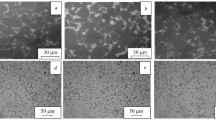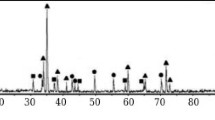Abstract
In this paper, dense ceramic materials based on silicon carbide have been obtained by the method of reactive sintering with a high level of mechanical properties, used as friction units (sliding bearings, parts of friction pairs) and high-temperature products, refractory materials, etc. The effect of the different dispersed composition of silicon carbide powders on the microstructure, grain size after sintering, and the physical and mechanical properties is shown.


Similar content being viewed by others
REFERENCES
Briggs, J., Engineering Ceramics in Europe and the USA, Worcester, UK: Enceram. Meith Wood, 2011.
Kolomeichenko, A.V., Increasing the wear resistance of cermet coatings applied by the method of carbovibro-arc hardening, Probl. Mashinostr. Avtom., 2019, no. 4, p. 4.
Drozdov, Yu.N., Tribology of technical ceramics, Probl. Mashinostr. Nadezhnosti Mash., 2003, no. 6, p. 51.
Nosenko, V.A., Influence of contact interaction on wear of an abrasive tool during grinding, Probl. Mashinostr. Nadezhnosti Mash., 2005, no. 1, p. 73.
Drozdov, Yu.N., Prikladnaya tribologiya (trenie, iznos, smazka) (Applied Tribology (Friction, Wear, and Lubrication), Drozdov, Yu.N., Yudin, E.G., and Belov, A.I., Moscow: Eko-Press, 2010.
Garshin, A.P., Gropyanov, V.M., Zaitsev, G.P., and Semenov, S.S., Keramika dlya mashinostroeniya (Ceramics for Mechanical Engineering), Moscow: Nauchtekhlitizdat, 2003.
Garshin, A.P. and Chulkin, S.G., Reaktsionnospechennye karbidokremnievye materialy konstruktsionnogo naznacheniya. Fiziko-mekhanicheskie i tribotekhnicheskie svoistva (Reaction-Sintered Carbide-Silicon Materials for Construction Purposes. Physicomechanical and Tribological Properties), St. Petersburg: Politekh. Univ., 2006.
Paranosenkov, V.P., Chikina, A.A., and Andreev, M.A., Structural materials based on self-bonded silicon carbide, Ogneupory Tekh. Keram., 2006, no. 7, p. 37.
Paranosenkov, V.P., Chikina, A.A., and Shkarupa, I.L., Self-bonded silicon carbide OTM-923, Ogneupory Tekh. Keram., 2004, no. 2, p. 23.
Garshin, A.P., Structure and properties of construction wear-resistant materials based on silicon carbide obtained by reaction sintering, Doctoral (Eng.) Dissertation, St. Petersburg: Polytech. Univ., 2000.
Fedoruk, R.M., Primachenko, V.V., Savina, L.K., Poltarak, E.V., et al., Investigation of the effect of graphite additives and the specific surface area of silicon on thermal conductivity and other properties of reaction-bonded silicon carbide products, Sb. Nauchn. Tr., 2004, vol. 104, p. 31.
Huang, Q.-W. and Zhu, L.-H., High-temperature strength and toughness behaviors for reaction-bonded SiC ceramics below 1400°C, Mater. Lett., 2005, vol. 59, nos. 14–15, p. 1732.
Clijsters, S., Liu, K., Reynaerts, D., and Lauwers, B., EDM technology and strategy development for the manufacturing of complex parts in SiSiC, J. Mater. Process. Technol., 2010, vol. 210, no. 4, p. 631.
Sangsuwan, P., Orejas, J.A., Gatica, J.E., Tewari, S.N., et al., Reaction-bonded silicon carbide by reactive infiltration, Ind. Eng. Chem. Res., 2001, vol. 40, no. 23, p. 5191.
Wang, Y.-X., Tan, Sh.-H., and Jiang, D.-L., The fabrication of reaction-formed silicon carbide with controlled microstructure by infiltrating a pure carbon preform with molten Si, Ceram. Int., 2004, vol. 30, no. 3, p. 435.
Paranosenkov, V.P., Chikina, A.A., and Andreev, M.A., Structural materials based on self-bonded silicon carbide, Ogneupory Tekh. Keram., 2006, no. 7, p. 37.
Paranosenkov, V.P., Chikina, A.A., and Shkarupa, I.L., Self-bonded silicon carbide OTM-923, Ogneupory Tekh. Keram., 2004, no. 2, p. 23.
Garshin, A.P. and Chulkin, S.G., Reaktsionnospechennye karbidokremnievye materialy konstruktsionnogo naznacheniya. Fiziko-mekhanicheskie i tribotekhnicheskie svoistva (Reaction-Sintered Carbide-Silicon Materials for Construction Purposes. Physicomechanical and Tribological Properties), St. Petersburg: Politekh. Univ., 2006.
Perevislov, S.N., Evaluation of the crack resistance of reactive sintered composite boron carbide-based materials, Refract. Ind. Ceram., 2019, vol. 60, no. 3, p. 168.
Perevislov, S.N., Lysenkov, A.S., Titov, D.D., Tomkovich, M.V., et al., Production of ceramic materials based on SiC with low-melting oxide additives, Glass Ceram., 2019, vol. 75, nos. 9–10, p. 400.
Frolova, M.G., Leonov, A.V., Kargin, Y.F., Lysenkov, A.S., et al., Molding features of silicon carbide products by the method of hot slip casting, Inorg. Mater.: Appl. Res., 2018, vol. 9, no. 4, p. 675.
Perevislov, S.N., Lysenkov, A.S., Titov, D.D., and Tomkovich, M.V., Hot-pressed ceramic SiC–YAG materials, Inorg. Mater., 2017, vol. 53, no. 2, p. 220.
Lysenkov, A.S., Kim, K.A., Titov, D.D., Frolova, M.G., et al., Composite material Si3N4/SiC with calcium aluminate additive, J. Phys.: Conf. Ser., 2018, vol. 1134, no. 1.
Perevislov, S.N., Shcherbak, P.V., and Tomkovich, M.V., Phase composition and microstructure of reaction-bonded boron-carbide materials, Refract. Ind. Ceram., 2018, vol. 59, no. 2, p. 179.
Perevislov, S.N., Lysenkov, A.S., Titov, D.D., Tomkovich, M.V., et al., Materials based on boron carbide obtained by reaction sintering, IOP Conf. Ser.: Mater. Sci. Eng., 2019, vol. 525, no. 1.
Markov, M.A., Ordan’yan, S.S., Vikhman, S.V., Perevislov, S.N., et al., Preparation of MoSi2–SiC–ZrB2 structural ceramics by free sintering, Refract. Ind. Ceram., 2019, vol. 60, no. 4, p. 385.
Ordan’yan, S.S., Rumyantsev, V.I., Nesmelov, D.D., and Korablev, D.V., Physicochemical basis of creating new ceramics with participation of boron-containing refractory compounds and its practical implementation, Refract. Ind. Ceram., 2012, vol. 53, no. 2, p. 108.
Ordan’yan, S.S., Nesmelov, D.D., Danilovich, D.P., and Udalov, Y.P., Revisiting the structure of SiC–B4C–MedB2 systems and prospects for the development of composite ceramic materials based on them, Russ. J. Non-Ferrous Met., 2017, vol. 58, no. 5, p. 545.
Perevislov, S.N., Afanas’eva, L.E., and Baklanova, N.I., Mechanical properties of SiC–fiber-reinforced reaction-bonded silicon carbide, Inorg. Mater., 2020, vol. 56, no. 4, p. 425.
Author information
Authors and Affiliations
Corresponding author
Ethics declarations
The authors declare no conflict of interest.
Additional information
Translated by Sh. Galyaltdinov
About this article
Cite this article
Perevislov, S.N., Tomkovich, M.V., Markov, M.A. et al. The Influence of Dispersed Composition of SiC on the Physico-Mechanical Properties of Reactive-Sintered Silicon Carbide. J. Mach. Manuf. Reliab. 49, 511–517 (2020). https://doi.org/10.3103/S1052618820060072
Received:
Accepted:
Published:
Issue Date:
DOI: https://doi.org/10.3103/S1052618820060072




